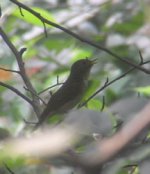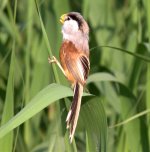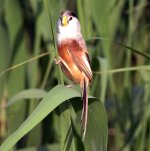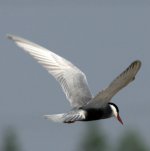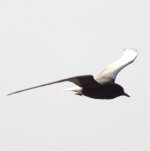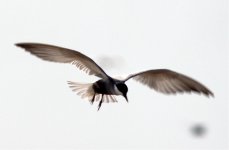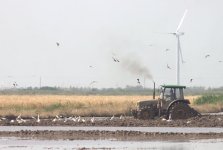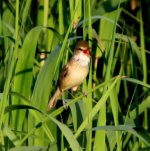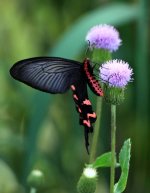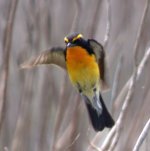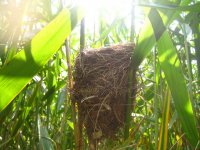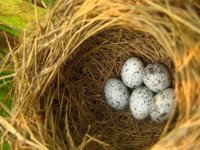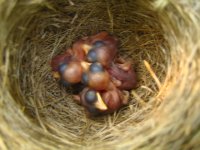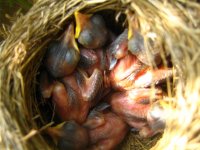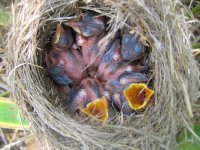breeding birds at chongming
I've been at Chongming Island off the coast of Shanghai for the past 2 months researching breeding salt-marsh passerines. Our initial attempts to find Zitting cisticola Cisticola juncidis and Marsh grassbird Locustella pryeri nests in Spartina alterniflora patches was an unmitigated disaster (2 nests in close to a month of searching, both of which were trampled by water buffalo. Ostensibly. Or an incredibly obese weasel, take your pick). We've had better luck working on the edge effect of Spartina on Phragmites patches, mostly focusing on Oriental reed-warbler Acrocephalus orientalis and Reed parrotbill Paradoxornis heudei nests.
Every day that we go nest-searching or -checking ends up being a day full of mucking around in "some lovely filth", and despite wearing hip waders, I almost always end up looking like I've soiled myself, much to the amusement of the local 渔民 (fisherfolk, yumin). But it's great getting to ride around on a scooter and during my time here, I've been able to see some lifers. Not nearly quite as good as my labmates up in Dandong (or ZL in Rudong!), who enjoyed what Terry Townshend termed the "magic bush".
Lifers thus far:
General:
1. Marsh grassbird Locustella pryeri 班背大苇莺 - it's been a real treat getting to see their dizzying display flights
2. Oriental reed warbler Acrocephalus orientalis 东方大苇莺. I was initially worried that we wouldn't see too many of this species, since it was a fairly late arrival. I needn't have bothered. This bird has the delicate, graceful song of a power saw cutting through plywood.
April 16-ish: Narcissus flycatcher (male) Ficedula narcissina, Blue-and-White flycatcher (male, only a brief glimpse, gone before I could get my camera, the SOB) Cyanoptila cyanomelana, Asian brown flycatcher
April 31:
1. (not a lifer, but a first sighting for 2012): Brown shrike Lanius cristatus 红尾伯劳
2. 100+ wood sandpipers Tringa glareola 林鹬 (right? can't be bothered to check)
3. my first Chinese pond heron Ardeola bacchus 池鹭 of the year (in Shanghai), in breeding plumage too
May 2 (very foggy day):
1. Eurasian hobby 燕隼 Falco subbuteo
May 15:
In the wheat/rice/aquaculture ponds near Dongtan, which were quite helpfully being tilled about by large tractors that attracted huge flocks of Cattle egrets in breeding plumage (not a year or life lifer, but exciting to see nonetheless), Caspian terns, and a few White-winged terns.
May 16:
1. The arrival of the Eurasian cuckoo Cuculus canorus 大杜鹃, several of which have parasitized some of our nests.
2. Chinese yellow bitterns Ixobrychus sinensis 黄苇yan, close to the Big Rock 大石头 entrance at Dongtan. Looks like they're breeding in the relatively pure, uninvaded Phragmites patches. We've found a couple of ground nests with large white eggs. Perhaps theirs? Also perhaps that of a Common moorhen or Eurasian coot?
May 29:
1. In the farmland near our field dorm - a few token Red-rumped swallows Hirundo daurica 金腰燕 flitting about the much more common Barn swallows.
2. Later that day at Dongtan--a flock of (what I was pretty sure were) White-winged starlings Sturnus sinensis 灰背椋鸟. The MacKinnon guide suggests that it only occurs as north as Fujian though...
June 3:
A rather flamboyant Lesser coucal Centropus bengalensis 小鸦鹃 making its low, hollow, watery burp of a call.
June 12:
A lone gray-headed lapwing Vanellus cinereus 灰头麦鸡, followed by 3 more on 6/18 near the Big Rock at Dongtan.
We're up to a grand total of 35 nests, which isn't brilliant, but not bad for only 2 people. We've also been told that nest searching in salt marshes usually produces pretty low nest numbers overall so hopefully we're not some desperately, pathetically slow slackers.
Shanghai-area birders---and the rest of you lot---please feel free to holler if you're ever heading out to Chongming. We've got nesting Kentish plovers and Black-winged stilts as well as all of our passerine nests amidst the mud, glorious mud.
Pictures attached of various birds. I'm hoping I can attach some videos I recorded of Oriental reed warbler and Reed parrotbill chicks, which are adorable and helpless and basically flap-flapping depositories of poop. Sometimes nicely wrapped in a fecal sac, other times...not.






